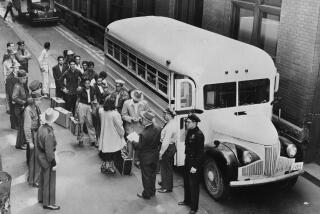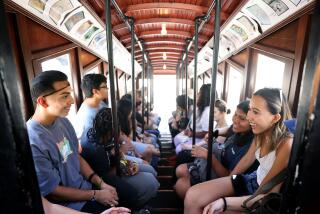Schoolkids Make History Their Story
Before last school year, Robin Frazier’s fifth-graders couldn’t have told you much, if anything, about the influential historian, author and journalist who built an unusual, artifact-filled home a century ago in their Highland Park neighborhood.
Yet here they are, students from Aldama Elementary School, appearing in a video professionally produced last spring about Charles Fletcher Lummis and El Alisal, the sturdy but fanciful rock-faced house he created along the Arroyo Seco.
Now these students can confidently recount the stories of the eccentric, adventurous Lummis and the home he built “to last 1,000 years.” And along the way, some have developed a love of history as well.
“That’s the thing I like most in middle school,” said Arturo Nava, 11, now in sixth grade at Luther Burbank Middle School.
The 15-minute video, with versions in English and Spanish, stemmed from a partnership between Aldama and the Historical Society of Southern California. The organization is housed at the Lummis Home and Garden, which is now a public museum.
“We want to make an impact in our own neighborhood,” said Thomas F. Andrews, the historical society’s executive director. Andrews started the partnership with Aldama as part of an educational outreach project sponsored by the History Channel; he has since expanded it with corporate grants to include other activities and additional schools.
“I think it’s important for students to know there is something of historical significance in their own neighborhoods, and that this history is theirs, too,” Andrews said.
Under pressure to raise student achievement scores, many schools are emphasizing subjects in which their students are tested -- reading, math and, soon, science. And years of tighter school budgets have eaten into funds for field trips to historic sites and other so-called extras, leaving educators and others worried that history -- and future generations -- would be shortchanged.
Financed by grants and often spearheaded by history organizations, scores of hands-on learning projects, which can be modest or elaborate, are popping up across the educational landscape. The History Channel’s “Save Our History” competition, for example, teamed community organizations with schools around the country last year and awarded cash prizes to 15 schools.
Nine Los Angeles Unified School District schools, including Aldama, participated. Belmont High School near downtown and Castelar Street Elementary School in Chinatown were among the national winners.
Belmont seniors worked on a project about the El Pueblo historic district’s Pico House, the first three-story building in Los Angeles. The Castelar students restored some floorboards from the underground tunnels in Old Chinatown there and used them to create artwork for the Chinese American Museum.
In the South Bay, the Friends of the Rancho San Pedro is raising money to offer free bus trips for students to tour the newly restored Dominguez Rancho Adobe Museum, a free-admission landmark that will hold reopening ceremonies on Sunday.
“One of the first expenses cut for many schools is field trips,” said museum spokeswoman Jean Walker. “We are endeavoring to leap that hurdle by providing field trips to the museum, free of cost to any school that would like to visit.”
Not far from the Lummis Home, eighth-graders at the Arroyo Seco Museum Science Magnet School train to become docents at the Southwest Museum, founded by Lummis himself.
It is those kinds of close encounters with history that the historical society’s Andrews had in mind when he and his staff began working with Aldama Elementary students, who walked a mile from their campus to the Lummis Home and back four times during their studies.
Besides working on the video, which is shown to Lummis Home visitors and is being distributed to other schools in the area, Aldama students made watercolor paintings of the home and gardens, kept journals about their visits, completed a timeline of Lummis’ life and other aspects of California history, and traced his footsteps on his 3,507-mile trek from Ohio to California. They even created a “vocabulary bingo” game of the new words they learned during the project.
Andrews and Michele Clark, a historical society staff member who is coordinating the organization’s “Keeping History Alive” project, are hoping to enlist another 11 area elementary schools in programs similar to the one the Aldama students pioneered.
“We want to turn kids on to history and augment what the schools can do,” Clark said during a recent meeting to explain the program to fourth- and fifth-grade teachers and Principal Sandra Carter at Glassell Park Elementary School. She said she wanted guidance from teachers to make the students’ experience as meaningful as possible, without burdening teachers with a lot of extra work.
Frazier, the Aldama teacher, said the project provided students with a “unique hands-on opportunity to learn about history.” She said they worked hard to master challenging material and developed greater self-confidence as a result.
“These kids are pretty much first-generation immigrant kids,” said Frazier. “They really didn’t have any American history, so this was a really new, very exciting experience for them.”
Their excitement is evident in the video. Dressed in their navy blue and white school uniforms, hair neatly combed or braided, the students take turns leading viewers through the rooms and garden, talking animatedly about the house’s many interesting features and about Lummis’ life.
The thrice-married former city librarian and Los Angeles Times city editor built El Alisal (“place of the sycamore” in Spanish) not only to entertain prominent people of his day (Theodore Roosevelt was among his guests). He also aimed to preserve a record of life along the Arroyo Seco and other important vestiges of days gone by, which is why he wanted it built to last many centuries.
The students tell the stories behind family portraits and point out the artifacts that reflected Lummis’ love of Southwest Native American culture, the home’s elaborate doors and fireplaces and even the hiding place Lummis used to dodge unwelcome guests.
Months after they finished the project and moved on to middle school, the students still talk enthusiastically -- and in great detail -- about the man and his house.
“It was amazing,” recalled Evelyn Sabian, 11, ticking off the things that had impressed her most -- the door with an elaborate “L” carved into it, the baskets and rugs, the stone towers, and even the wooden toilet seat Lummis “made by himself” from a tree stump.
“I didn’t like history so much before,” Evelyn said, “But since we went to Lummis’ house, I like it a lot more. I think it’s important to us for our future.”
More to Read
Sign up for Essential California
The most important California stories and recommendations in your inbox every morning.
You may occasionally receive promotional content from the Los Angeles Times.










